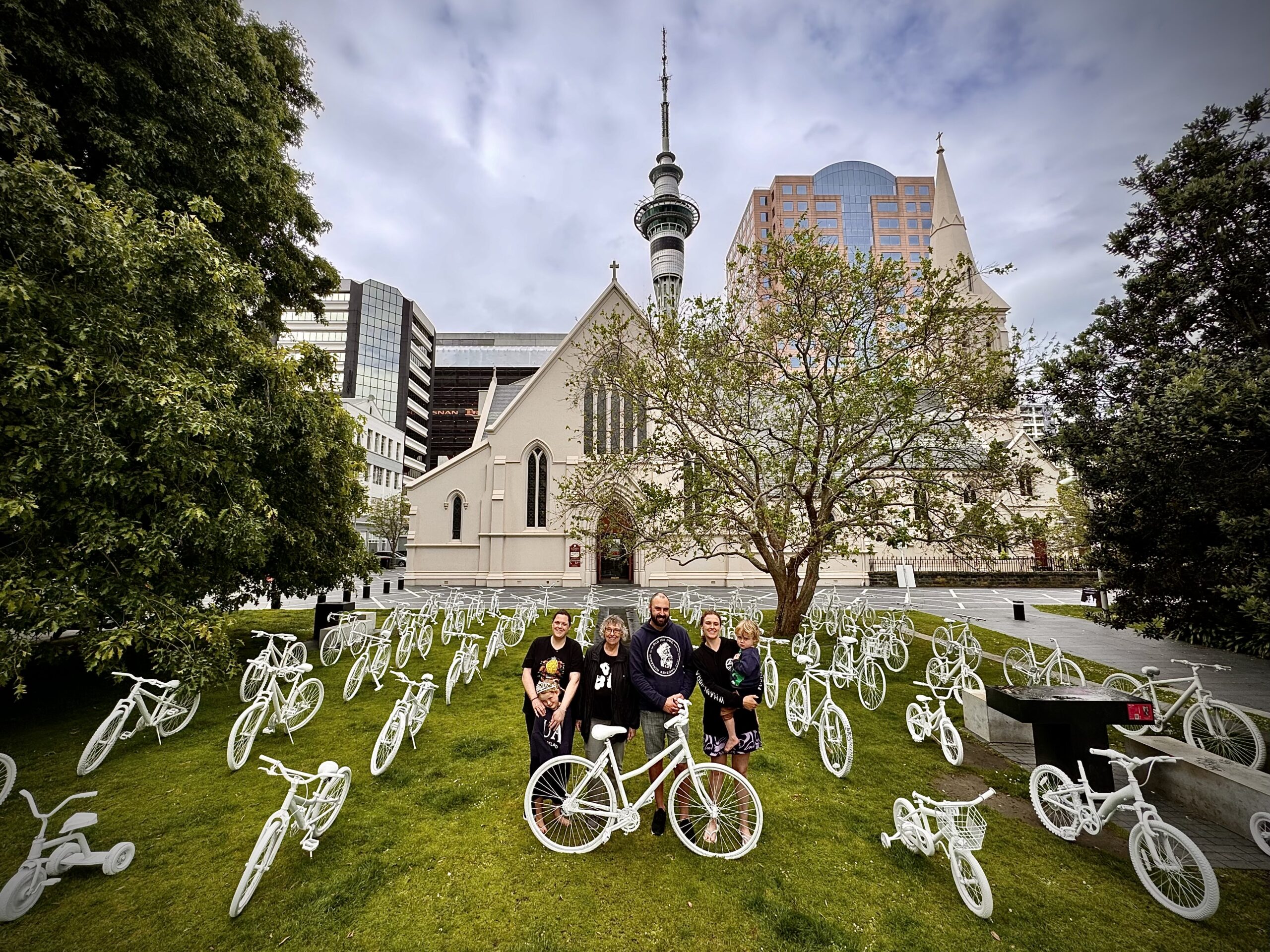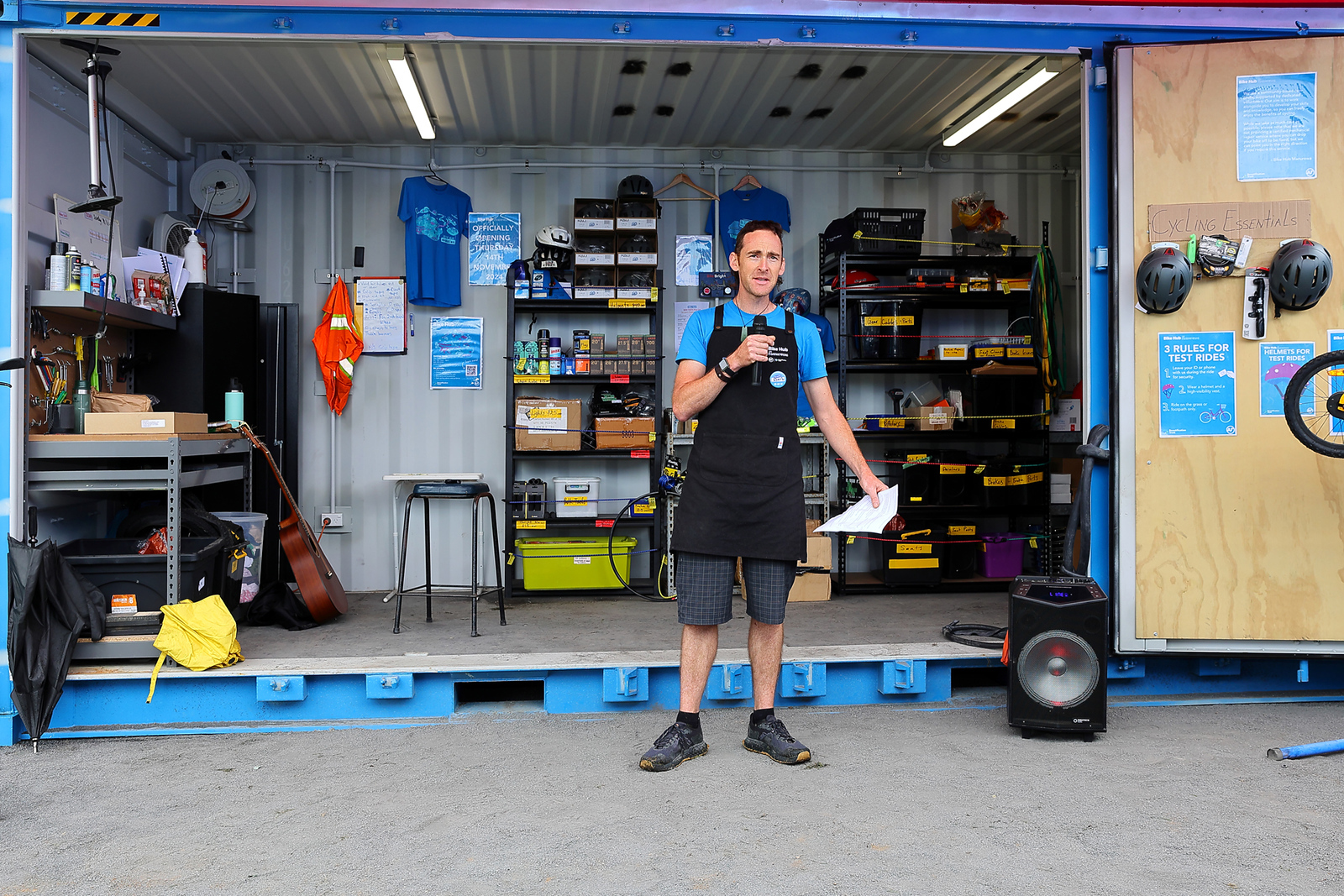Every year, in celebration of Pride Month (February) and the growing local cycle facilities, Rainbow Riders Tāmaki Makaurau create ‘Yarn for Pride‘, decorating the cycle parking along Karangahape road with colourful and funky knitted or crocheted scarves. Not only does it bring a smile to passers-by, but it’s also easy for beginner knitters and crocheters to get involved.
Want to do something similar and decorate your local bike parking, or want to make something for Yarn for Pride? Read on for some tips.
Contents – skip to….
- About Yarn for Pride
- Yarnbomb thy bike parking
- Step 1: the yarn
- Step 2: the colour
- Step 3: the bike parking
- Step 4: Knit or crochet your scarf
- Step 5: Sew it on
- Step 6: Re-visit your creation
- Step 7: Removal
- About getting a Permit
A little bit about Yarn for Pride
This is our third year yarnbombing (decorating with yarn) the cycle parking for Auckland Pride Month – and we’ve had so much fun! Seeing children beam with joy when they discover them, being thanked profusely by passing onlookers as we put them up, and simply admiring the colour they bring to the streetscape as we go by! These recollections bring within me a feeling of great Pride – quite appropriate as Yarn for Pride is a celebration of LGBTQIA+ Pride month, as well as a celebration of Pride in our growing cycle network.
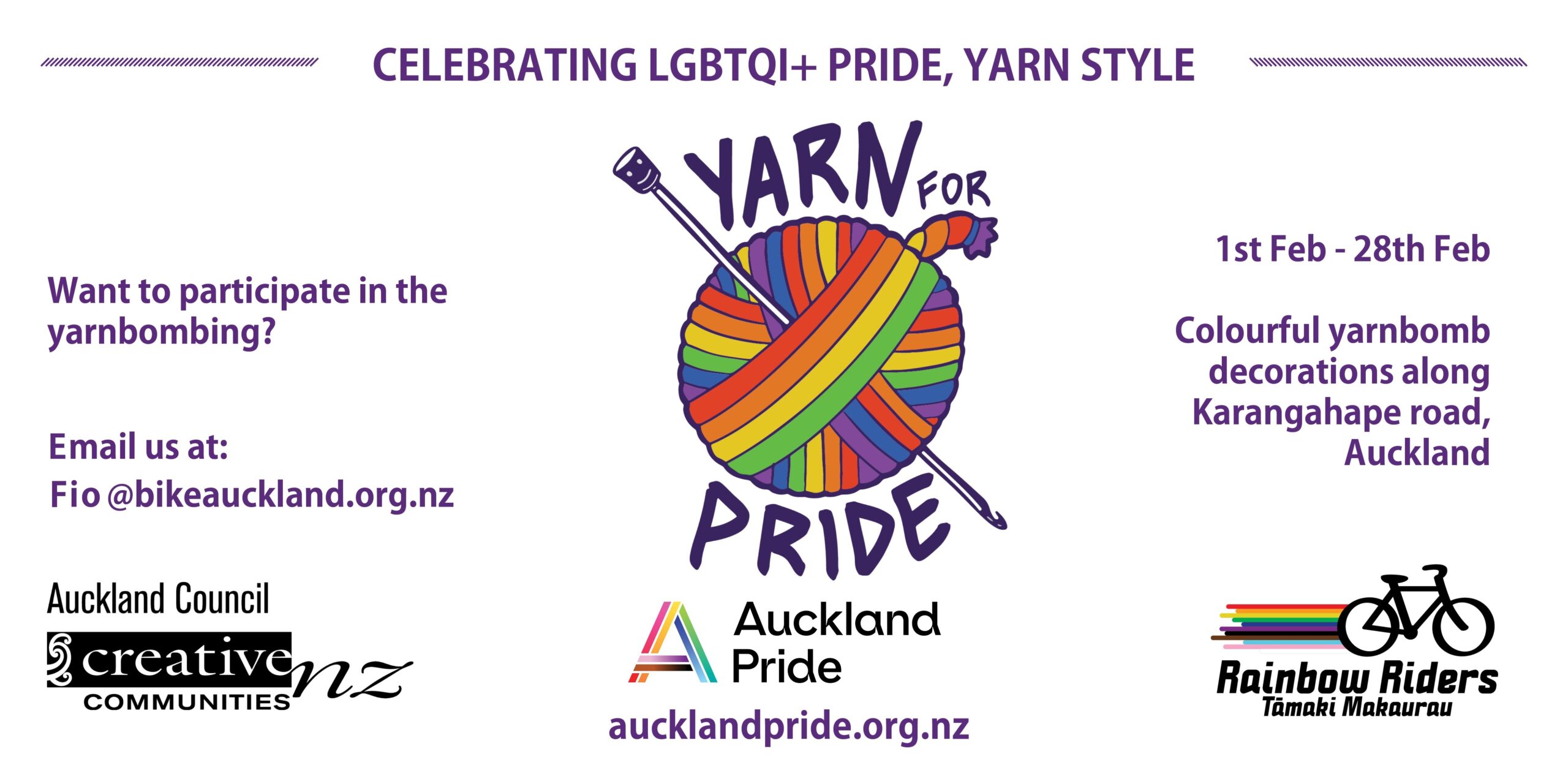
Yarnbomb, verb: cover (an object or structure in a public place) with decorative knitted or crocheted material, as a form of street art. (Thanks Google!) Yarnbombing has also been dubbed “gentle graffiti”.
Why bike parking?
Because it’s easy to yarnbomb! It is as simple as making a scarf of the right width and sewing it on – and it looks fab! Making a scarf is one of the easiest things for a beginner crocheter or knitter to do. Also there are typically a fair amount of bike parks outside shops, which makes for an easy way to bring colour and fun to areas with higher foot (and bike) traffic. And, bike riders appreciate having something soft covering the bike parking, because it stops their bikes from getting scratched by the metal.
On top of all of this, we love having safe, secure bikes, and bike parking is crucial for solid security. We love to show some love for our bike parking! It really is win-win-win!

Why along K road?
Primarily because Karangahape road has an important history for our LGBTQIA+ community. But also because when Yarn for Pride first started the K rd cycleway had only just opened. The cycleway connects to the North Western via East st and Upper Queen street. It connects to Nelson st cycleway via Te Ara I Whiti, the Pink Pathway. If you don’t mind going on a stretch of busy road, Waihorotiu path (the relatively new Queen street shared path) is not far away and will soon connect with Te Hā Noa, a protected cycleway along Victoria street beside the new Te Waihorotiu train station.
In the not-too-far-future two new cycleways will connect into K road as well: the hard-fought-for stretch of Great North Road from Karangahape rd to the Grey Lynn shops (one of three Inner West street improvement projects), and another along Pitt Street as part of the Karanga-a-hape station neighbourhood improvement project (which also includes a pedestrian mall on Mercury Lane). So this year (if we have enough scarves) we will decorate some of the bike parking along these streets as well!
Want to get involved with Yarn for Pride and help out? Message Yarn for Pride on Facebook or email fio@bikeauckland.org.nz
We now feel we’ve learnt enough about yarnbombing cycle parking that we can pass on a bit of knowledge and empower others to bring a bit of colour to their bike parking too; perhaps in this endeavour you will feel the same Pride we do.
So… Yarnbomb thy bike parking
If you’re keen to decorate some bike parking but not sure where to start, this guide is for you!
However, a quick warning: If you are someone who is likely to get quite upset if someone removes or damages your creation once it is up in the public space, then perhaps this is not the project for you. The pieces do sometimes go missing (we reckon it’s cos they are super cool and people can’t resist taking them to use as actual scarves), and they are sometimes damaged (sure it may sometimes be on purpose, but it’s probably often by accident as well. For us in particular, Karangahape road is a party spot and drunk people tend to steal random things).
If you reckon you’d be okay with your creation disappearing (que sera sera – whatever will be, will be) then read on, this is just the project for you!

Note: If you want to make sure that you are decorating the bike parking legally, skip to the bottom for some information about getting a permit. If you’re joining in with Yarn for Pride though, don’t worry, we already have a permit and it will cover you popping your creation up along the bike parking on Karangahape road too!
Second Note: We’re using ‘scarf’, ‘piece’, and ‘yarnbomb’ interchangeably to refer to the decorations on the bike parking.
The how-to guide
Step 1
The yarn
When choosing which type of yarn to use, consider:
- Your values – Do you want to use biodegradable yarn? Are you concerned about microplastics entering our waterways? Do you think a longer-lasting yarn will be more resource friendly? Are you concerned about the resources that go into making the yarn, or how far it is shipped to reach you? Do you avoid using products from animals?
- Stretch – yarnbombing requires yarn that doesn’t stretch much
- Your price range. For our project we get funding from Creative Communities Scheme which allows us to be more choosey about which yarn we use.
For Yarn for Pride we decided to use yarn that would be biodegradable and wouldn’t shed microplastics into our waterways. This meant that, although an acrylic yarn would last longer, we were choosing between cotton and wool. Wool is too stretchy to easily use for yarn bombing and also absorbs a lot of water when it rains, making it a bit yuck, so we decided cotton was the best option. We experimented a little with a bamboo cotton blend but found that it felt slippery and frayed too easily, making it hard for beginners to use, so we settled for a 100% cotton yarn.
The cotton that we purchase is marketed as being sustainably grown but it is shipped from overseas so it still adds carbon miles. The colour of cotton yarn fades quite fast in the sun, which is definitely a drawback.
For us this was the best ethical choice, but I do know other environmentalists who choose to use acrylic yarn because to them the longer lifespan of the yarn makes it a better environmental choice overall.
It’s up to you to choose your own preferences and trade offs and what would best suit you.
Note: The thickness of the yarn is also important to consider. We typically supply 8ply because it’s easy to find, and it’s relatively easy to use for beginners regardless of the needle or crochet hook size used. If you’re a beginner, we recommend getting 8ply yarn.
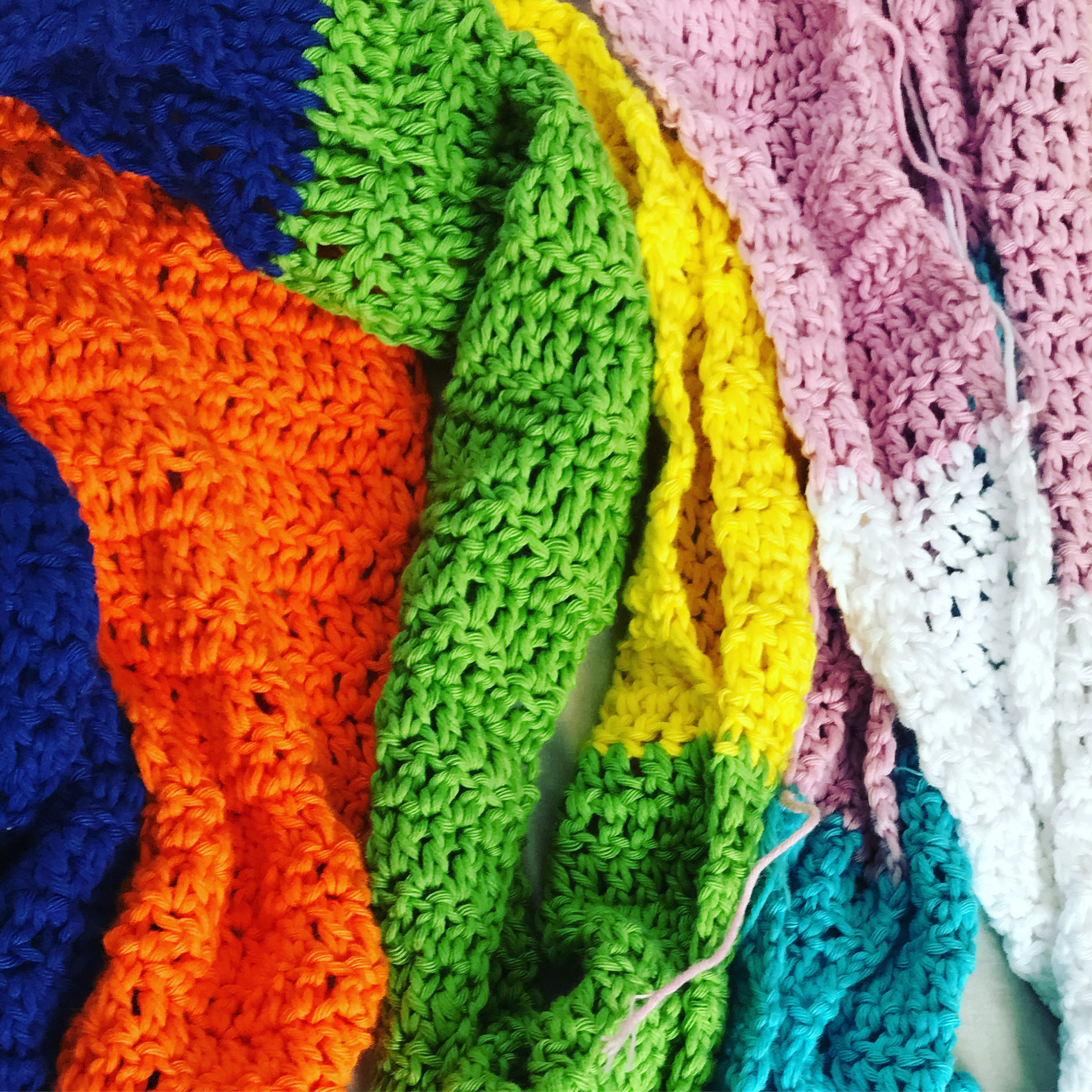
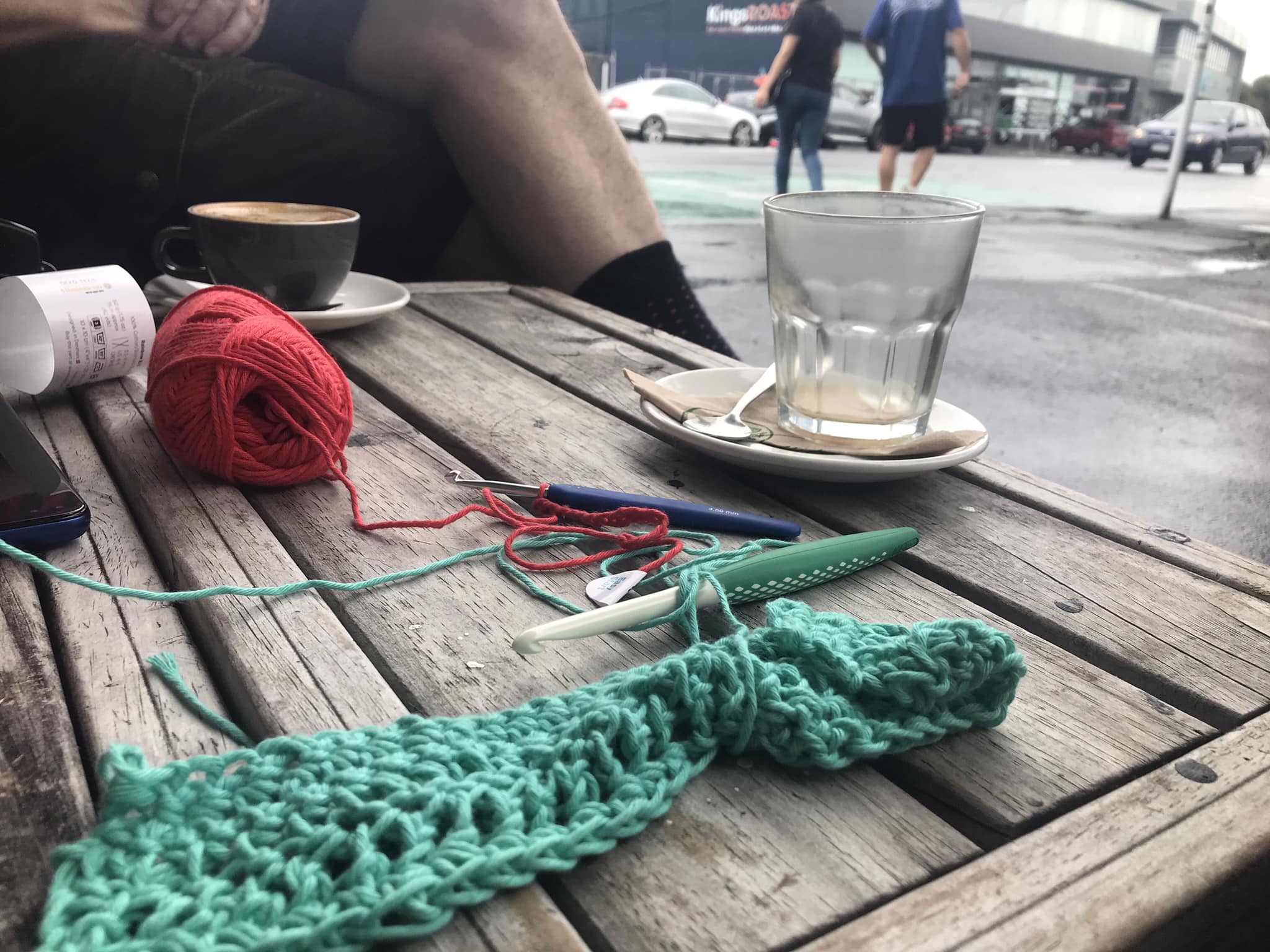

Of course, the best yarn is the yarn that otherwise would not be used! We quite often get donated acrylic yarn from people, which is fantastic and is always divvied out to volunteers to be put to good use for Yarn for Pride! People also join in and make scarves out of whatever yarn they have lying around at home, so the yarnbombs end up being a mixture of a wide variety of yarn types.
Step 2
The colour scheme
You might like to choose colours which relate to something culturally significant to you eg. red, white, and black are culturally significant for Māori designs. Or, you may want to simply choose colours that you like, random colours, to make a fun and funky design (whether it has additional symbolic meaning or not). All are great options!
For Yarn for Pride the yarn we supply is usually in the colours of the progress pride flag (this means the rainbow colours, and then also brown, black, light pink, light blue, and white). We focus on these colours because many people choose to make designs from colours which relate to the Pride flags eg. light pink, white, and light blue for trans flag colours, or yellow, pink, and blue for the pansexual flag colours. We tend to also include some grey to provide the option for flag colours which represent the Asexual spectrum. Some of the designs people make are unrelated to the flag colours, and are simply random and fun and colourful too!
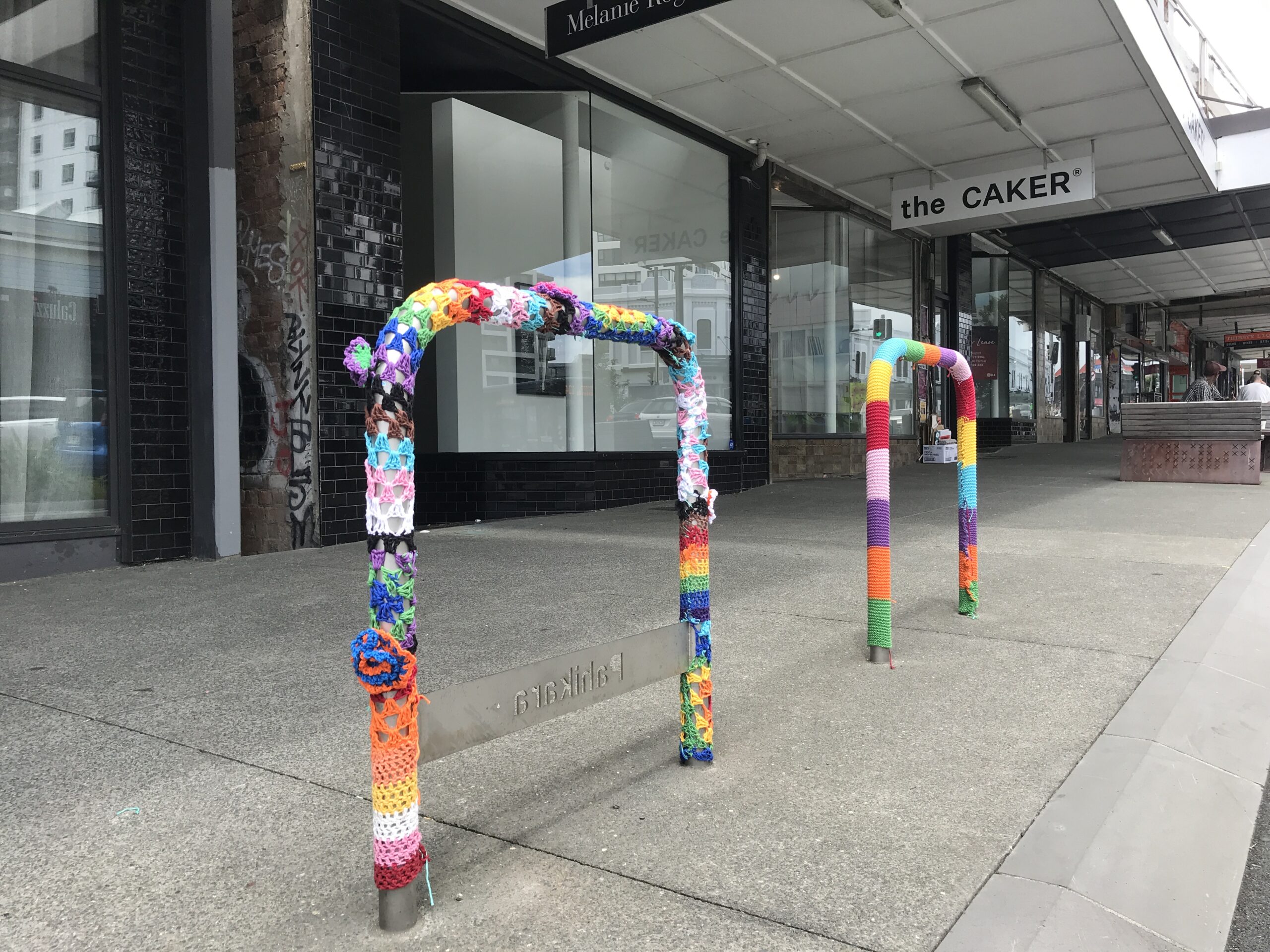
Step 3
The bike parking
Measure the bike parking which you want to decorate.
Staple style bike parking (also known as ‘Sheffield Stands’) is 6.5 Inches in width, and 103 Inches long (16.5cm by 262cm). Typically the other bike parking styles across Tāmaki Makaurau Auckland are the same width but a shorter length. Measure yours to double check!
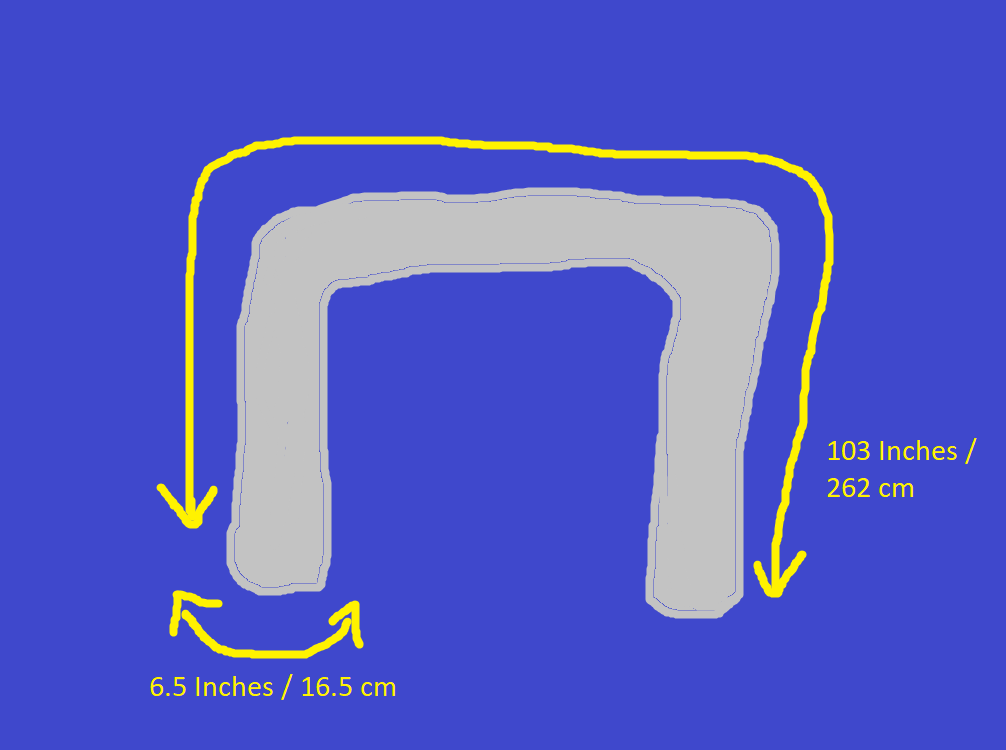
It’s best to make your scarf’s width smaller by 1 Inch. So, a scarf for the staple-style bike parking should be 5.5 Inches (14cm) in width.
Note: If you are using wool, or another very stretchy yarn, you should make your scarf even narrower. It’s easy to make it a little bigger if it ends up too narrow, but it’s not so easy to make it smaller if it ends up too wide!
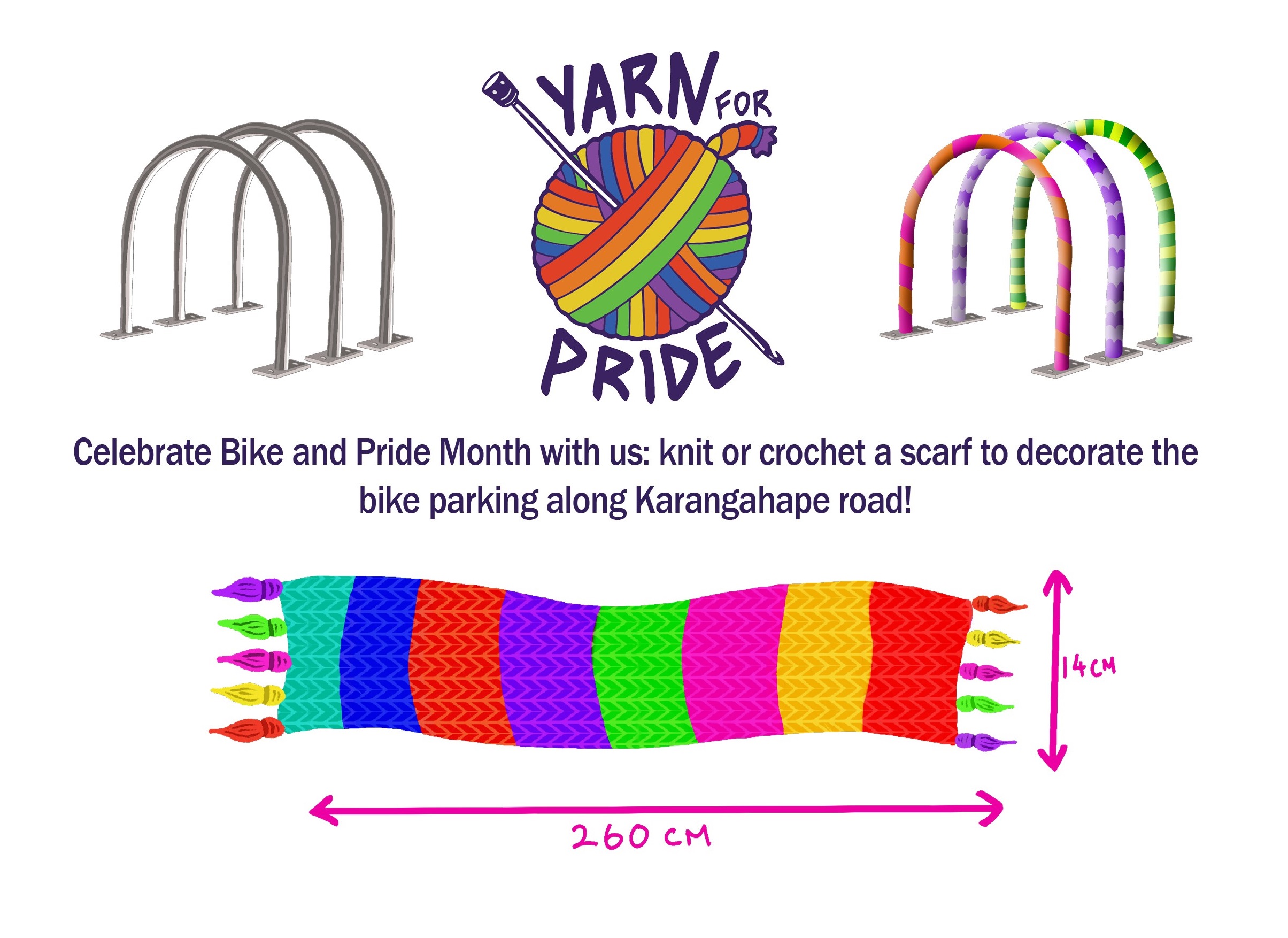
Making it that 1 Inch less in width will ensure it fits snugly, without moving around too much. This way, if someone leans on the decorated bike parking, the scarf won’t slip round and cause them to fall. We are quite concerned about fall hazards here!


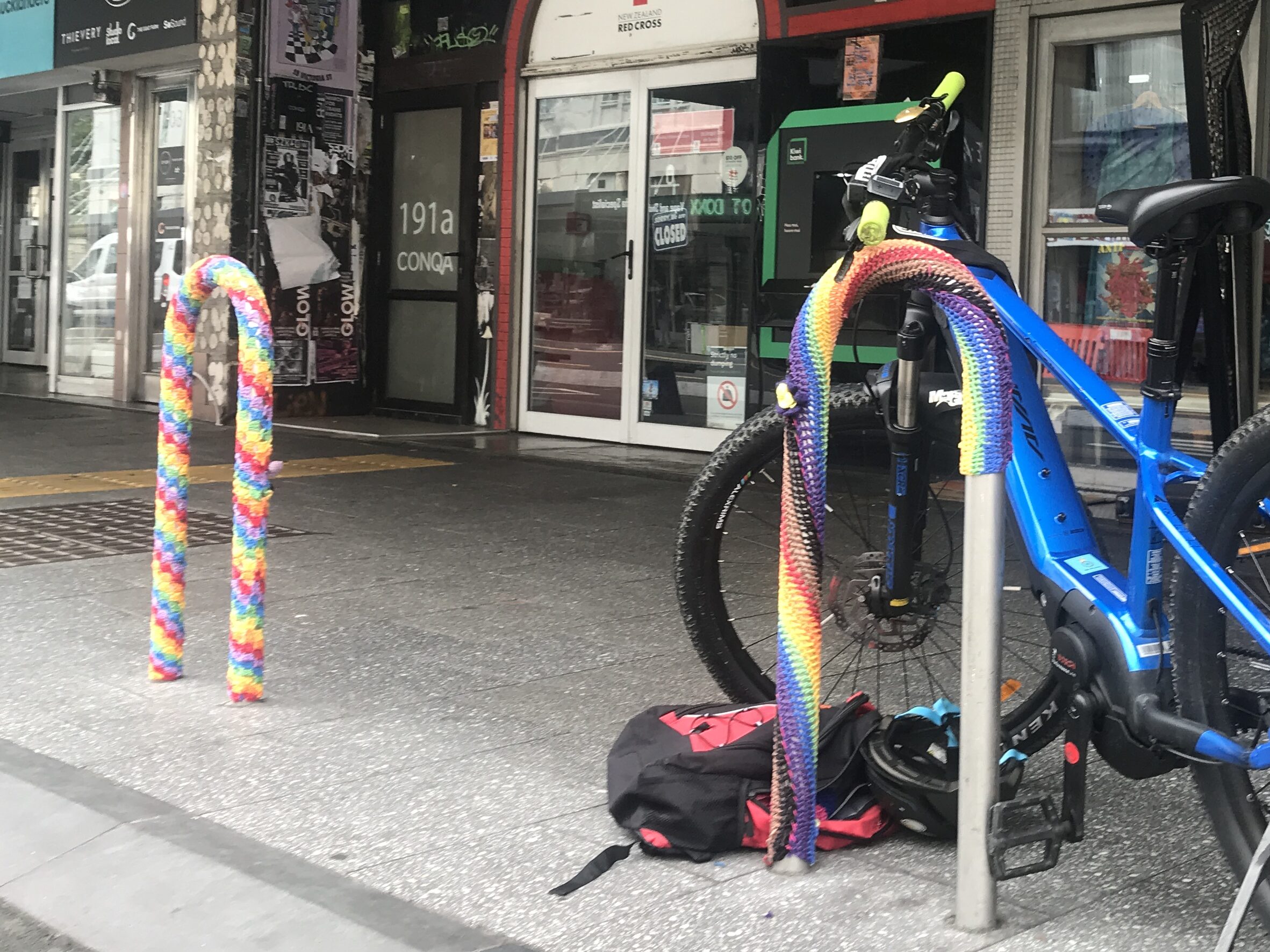
The smaller stands pictured above also exist. They have the same width as the staple-style parking, but we’ve forgotten how long they are. Potentially it was around 80 Inches. Will have to measure and update!
Step 4
Knit or crochet your scarf!
If you don’t already know how to knit or crochet, there are some great Youtube tutorials which can teach you – alternatively you can join a local knit or crochet circle, such as Queer Yarns, or one of Yarn for Pride’s meetups and we’ll teach you! I learned to crochet from Youtube videos during Lockdown in 2020 as a way to pass the time. I started by making fingerless gloves – this is a very hard project and I don’t recommend it for a beginner! I’ve completely forgotten how I managed it. Anyway – back to the scarves!
Scarves are a great beginner’s project – and if you’re more advanced you can get a lot more creative with colour changes and patterns. Once you’ve made the scarf you can also sew on fun and funky things like flowers, love hearts, bees, or a coloured chain in an interesting shape.
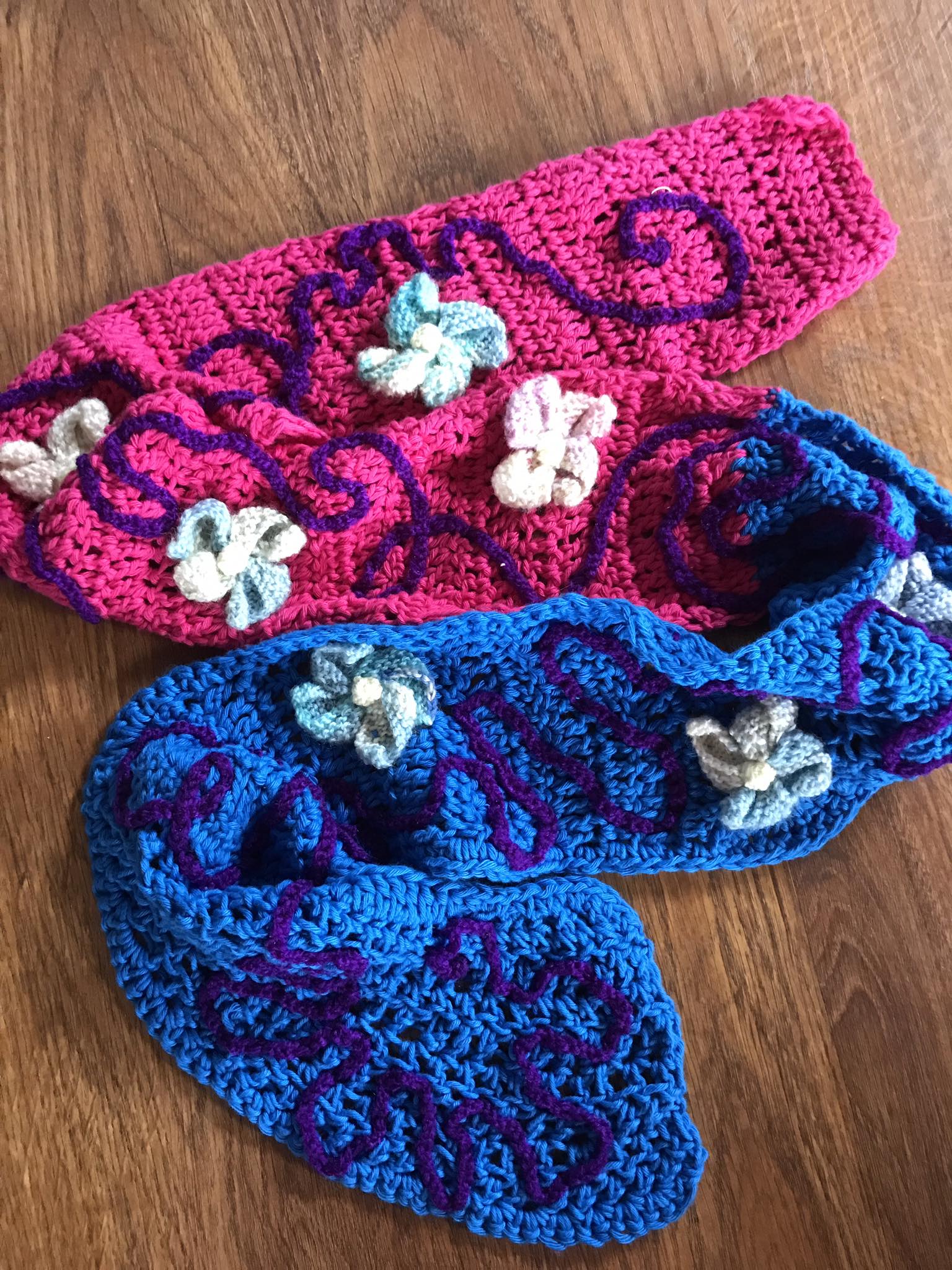

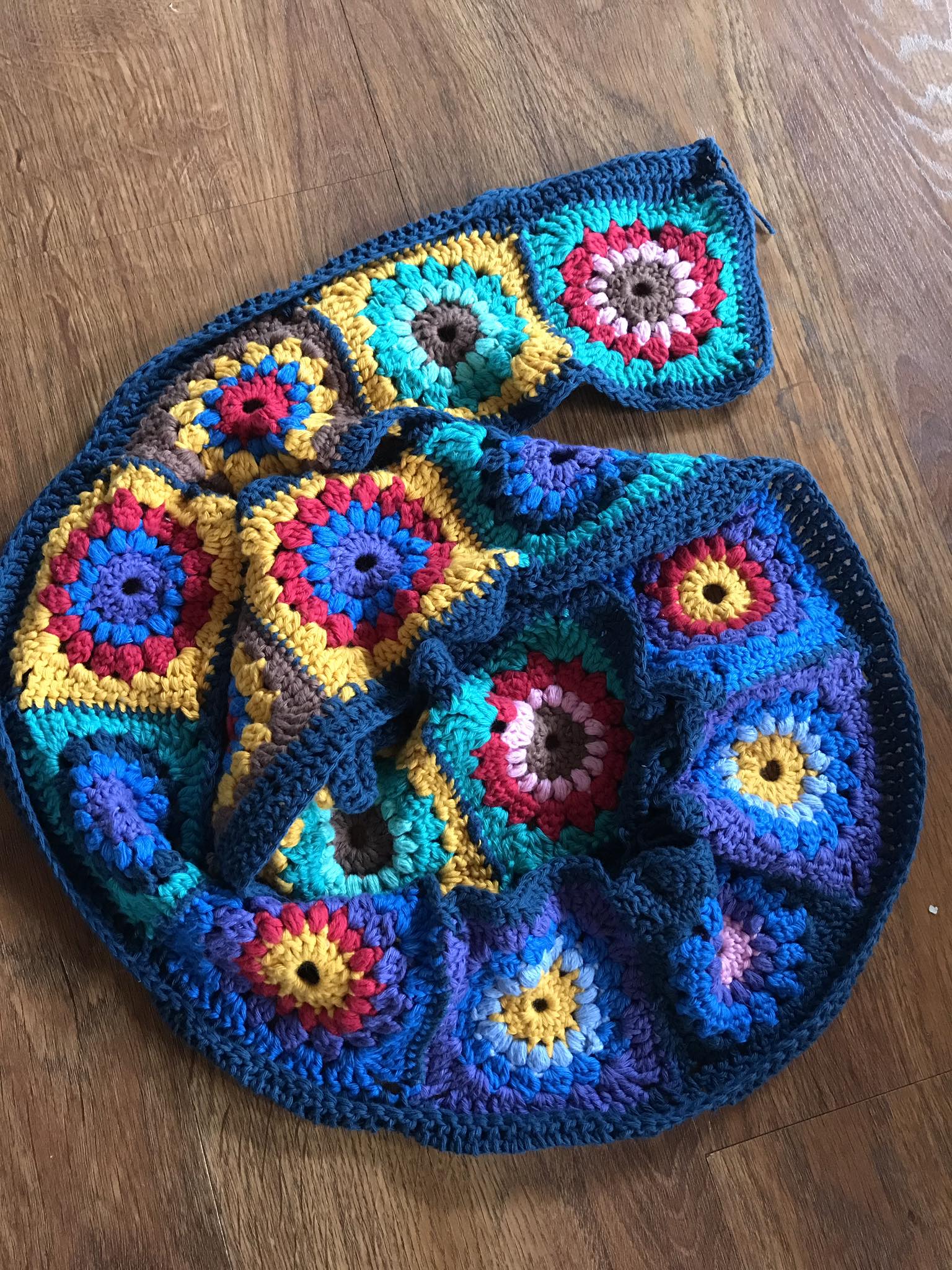
Consider:
- Single crochet stitches are tidy and firm but…
- Larger stitches (such as double crochet) and larger needles or hooks will help you to finish your scarf faster and will use less yarn. We recommend using a larger hook or needles if you are a beginner.
- Gaps between stitches (from using larger stitches / larger hooks or needles) will mean the bike parking shows through the decoration.
- Adding 3-D creatures (eg. a bee or caterpillar) to your design is fun but people sometimes pull on them and damage the piece. Consider if you mind if the piece is damaged like this. If you do decide to add a 3D creature make sure you keep a close eye on the piece and fix it or remove it if it gets broken.
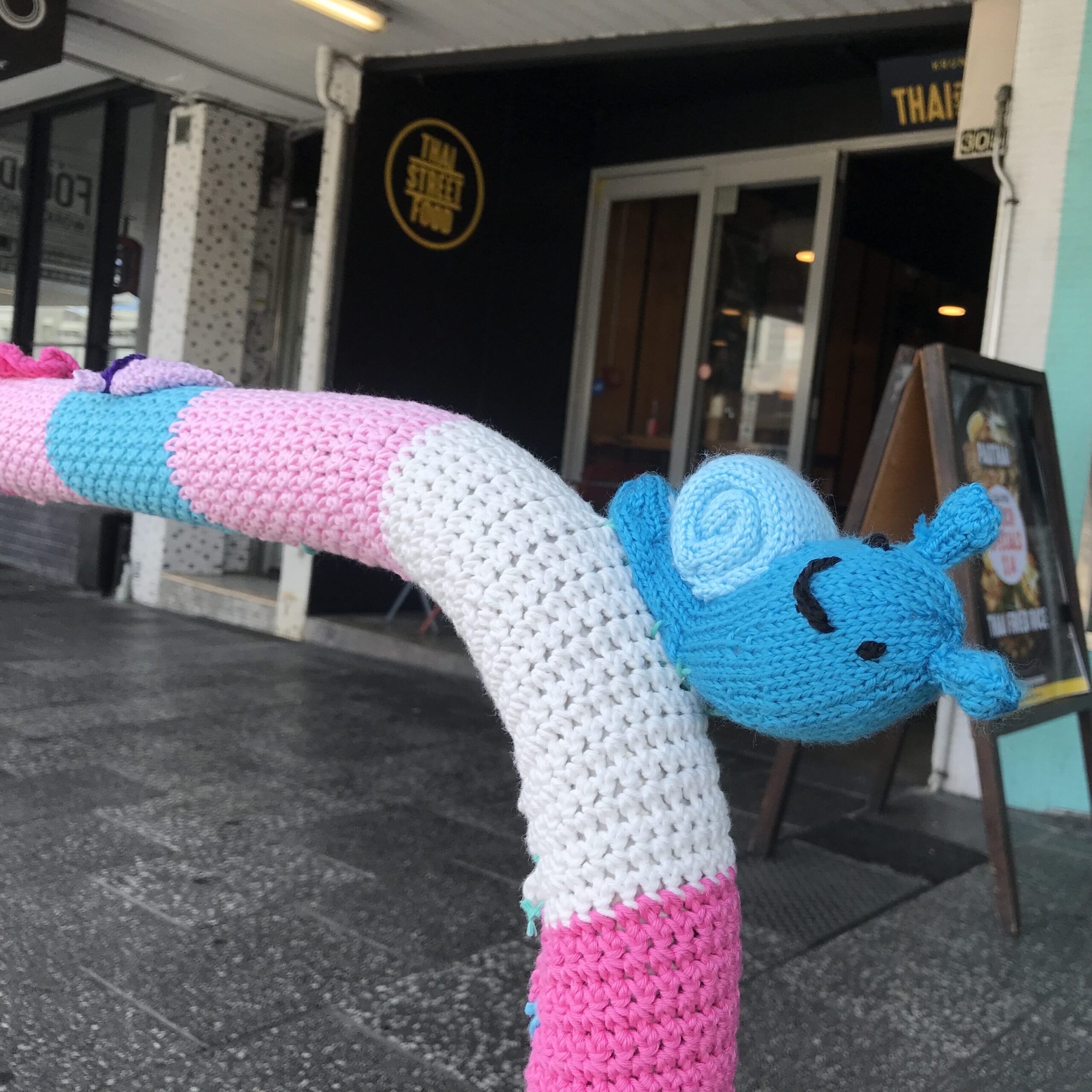

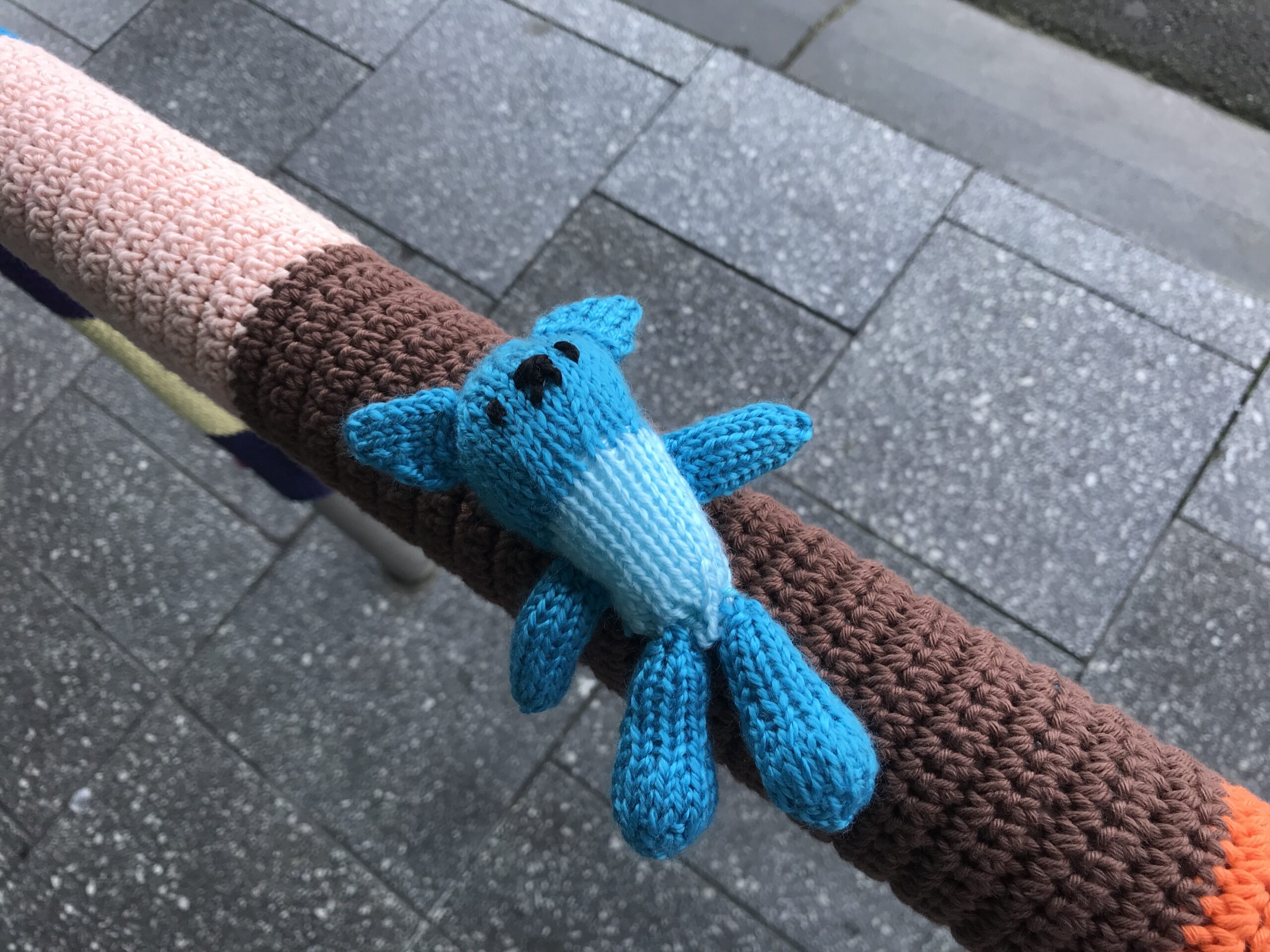
The bee pictured above got pulled on so much that it stretched the rest of the scarf, so that the bee was dangling downwards. After we repaired it the bee was finally stolen, leaving a massive rip in the scarf. We patched it with a love heart instead 🙂 The other creatures pictured above survived fine though!
Step 5
Sew it on!
So you’ve finished your scarf and decorated it? Great! Time to hand sew it onto the bike parking!
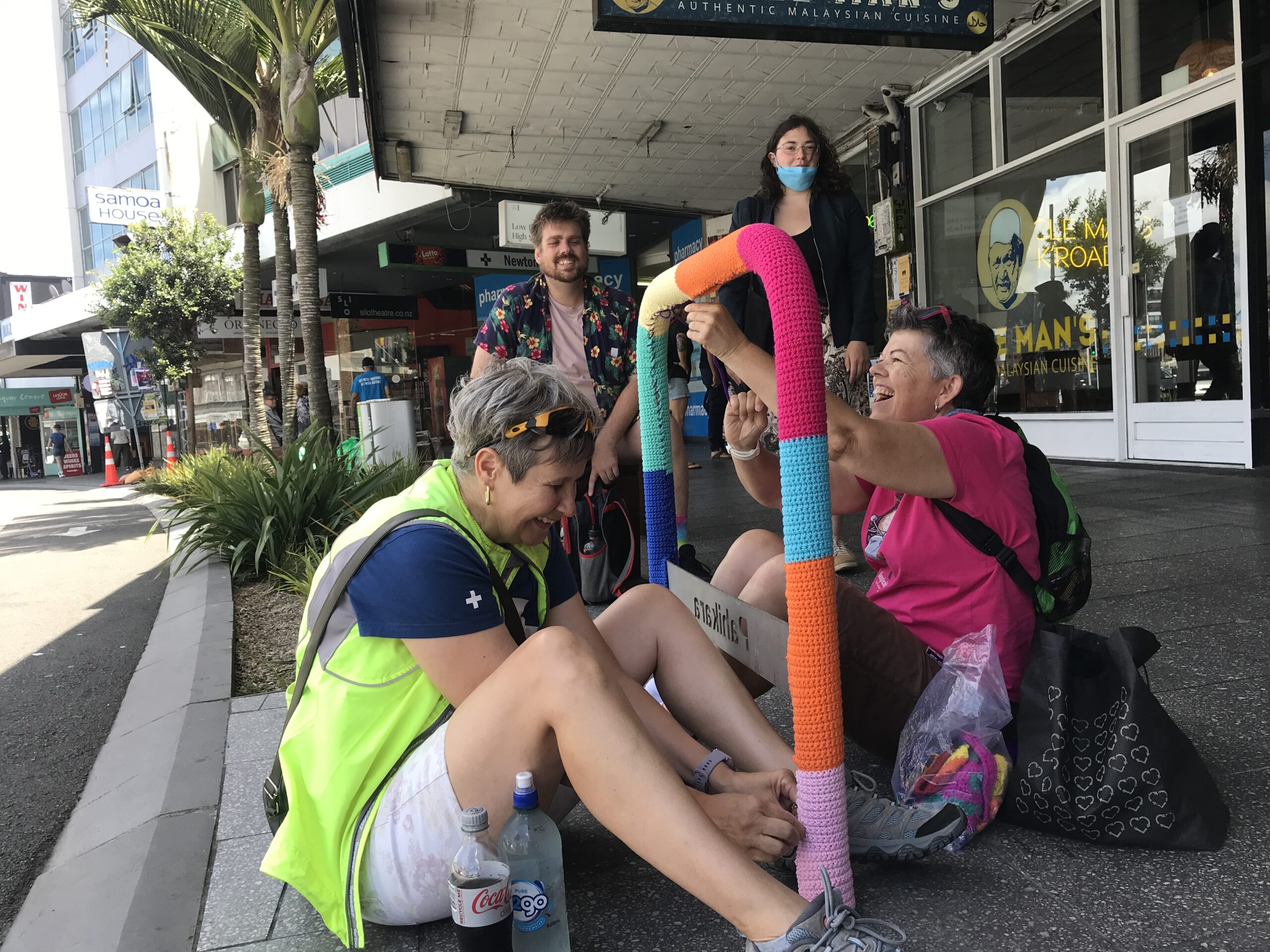
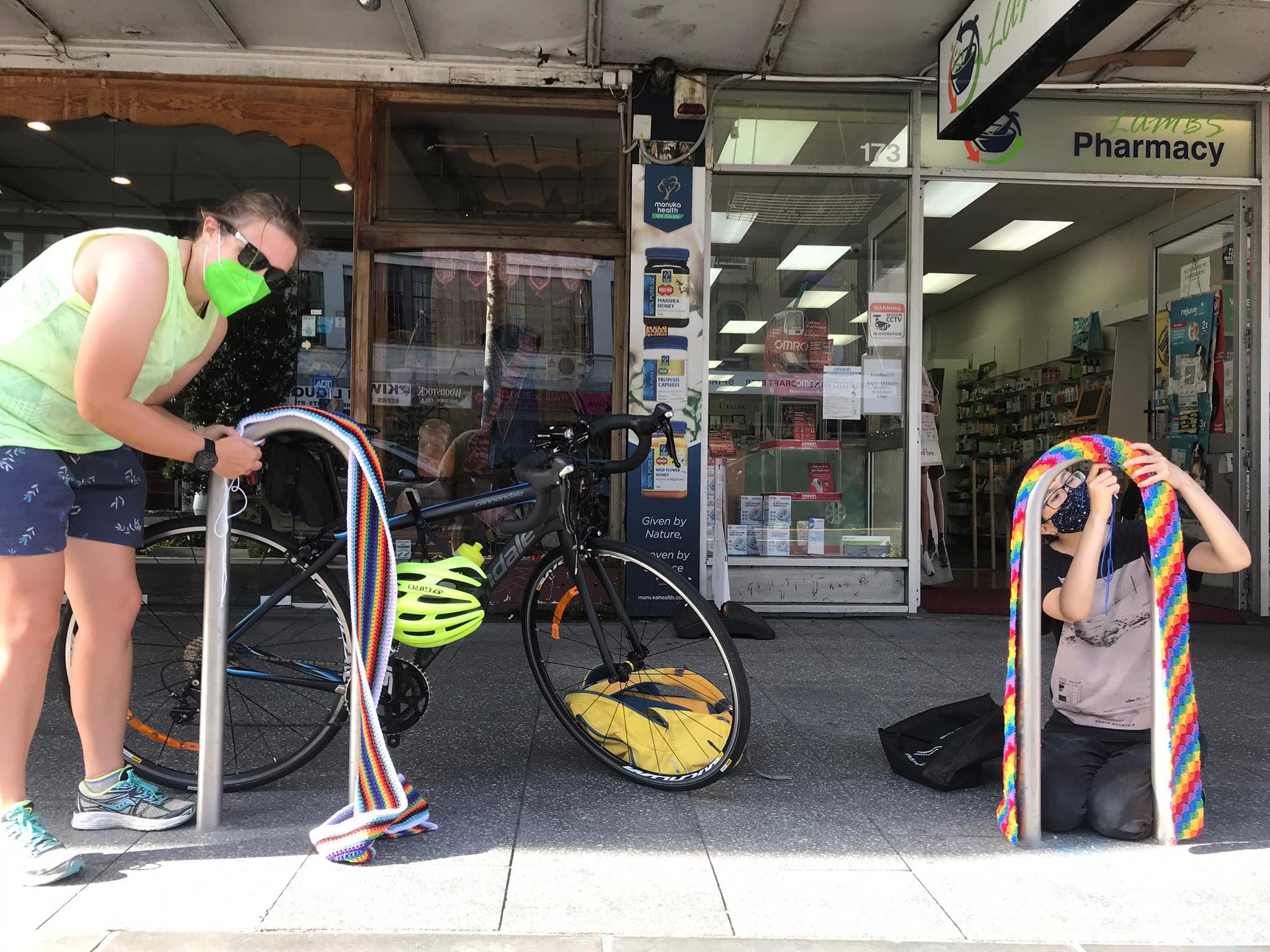
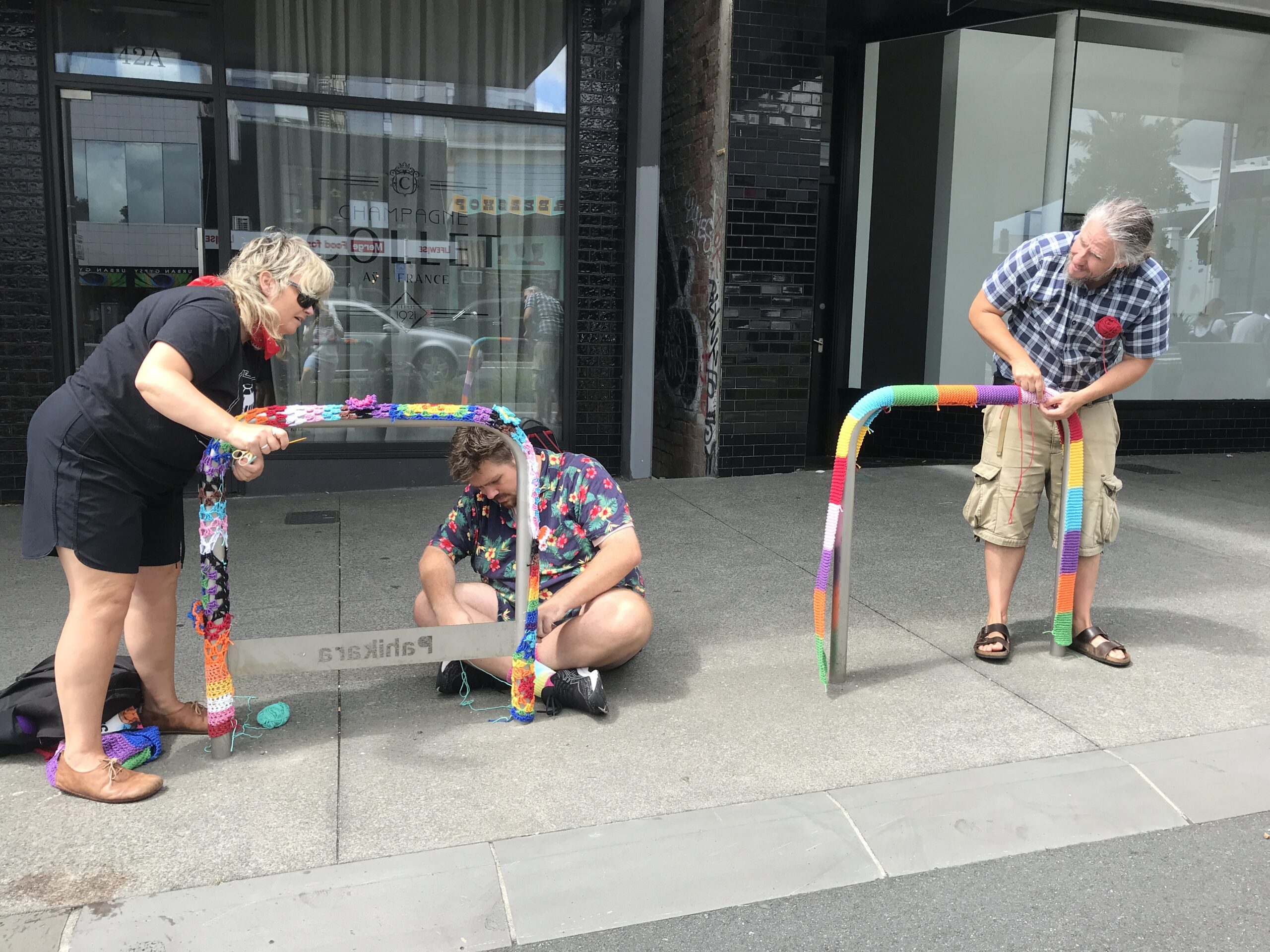
It takes roughly 30minutes to put one scarf on one bike park. With a friend’s help it’s faster!
You will need…
A wool needle for sewing
A contrasting colour of yarn (than your scarf is made from)
A bottle of water and potentially a snack, hat, and sunscreen
Some quick tips:
- Plan to put it up at a time of day when the temperature will be comfortable for you (eg. in Summer aim for early to mid morning or when the bike parking will be in the shade)
- Most people who talk to you will be complementing you on how great your creation looks but it’s still better to have a friend with you so that you feel safe. It probably won’t happen but just in case; if anyone is aggressive or intimidating avoid eye contact, stay silent, and walk away. If they continue to be scary call 111
- You can use safety pins, cable ties, or a friends hands to hold the scarf together around the bike parking while you are sewing it.
- Use a contrasting colour of yarn to sew the scarf onto the bike parking. This will make it easier for you to remove the piece later without damaging it.
- The sewing doesn’t have to be mega tidy, it just needs to pull the edges of the scarf together. People will be mostly looking at the top of the bike parking anyway so they won’t really notice the stitches. It’s fine to be fast and furious 😉
- Hide the ends of the thread by sewing them behind and into the scarf. Do not cut them too close to the knot or it will undo itself.
- Make sure to congratulate yourself for your awesome creation!
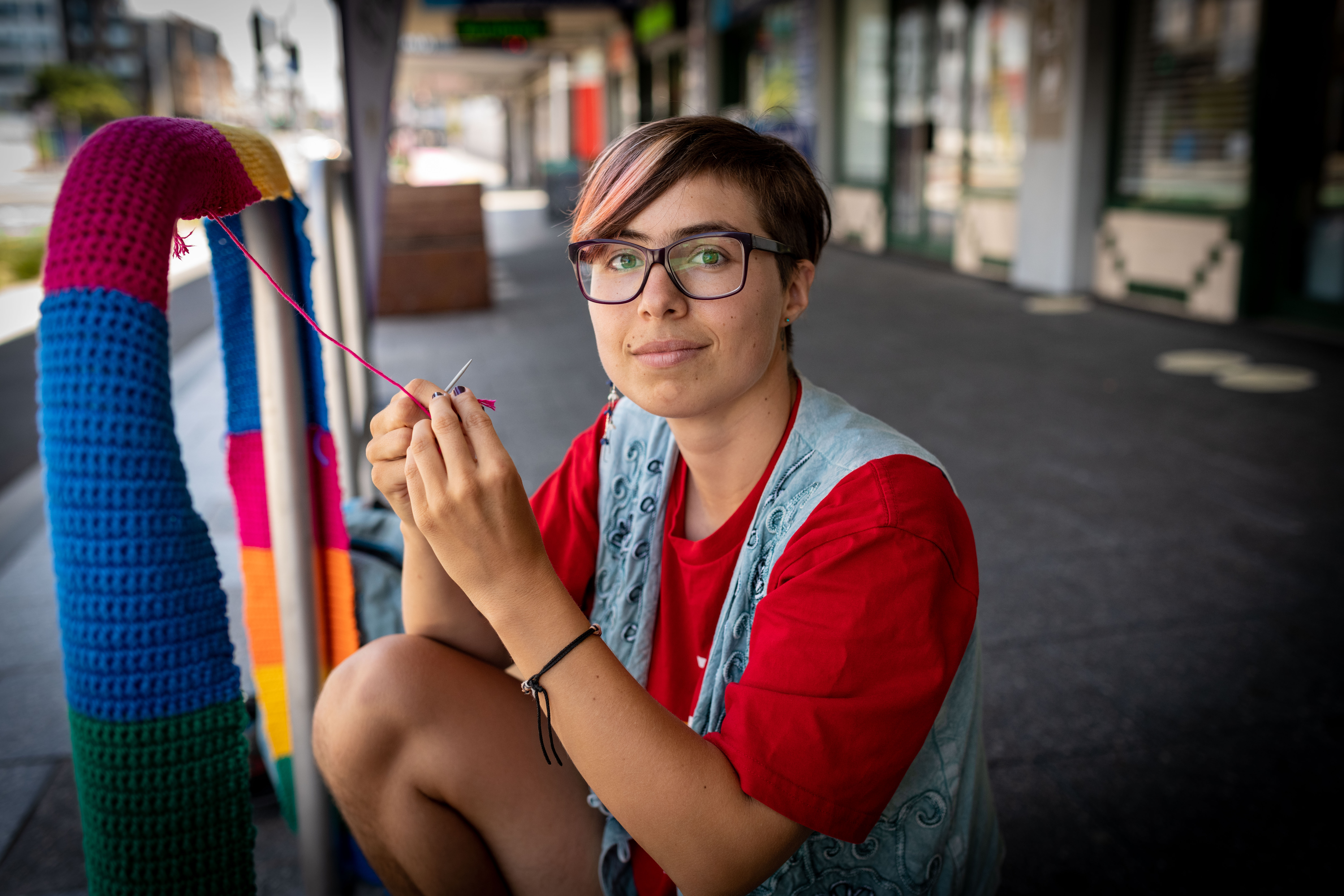
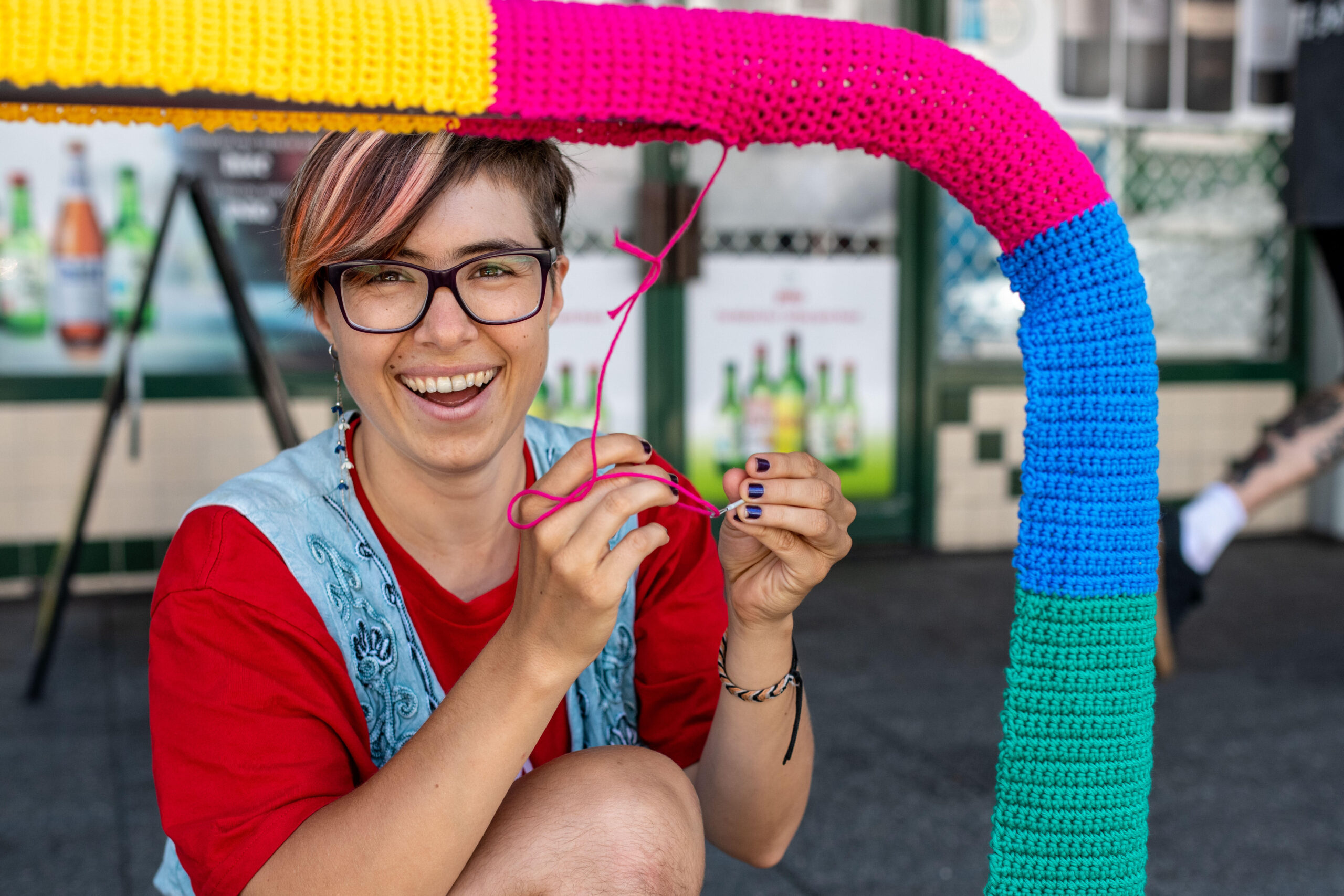
2022: A random passer-by asked if they could take a photo for me – and they took a lovely couple of snaps! It was shortly after this that we realised we should be using a contrasting colour of yarn!
Step 6
Re-visit your creation
Make sure to visit your creation regularly to check if it needs mending or removing. Decorating the bike parking beautifies the space and will bring smiles to lots of people (especially children!) but once it starts to look broken and faded it will be ugly-fying the space. So, make sure to keep an eye on it and to fix it or remove it when needed.
Alternatively, instead of visiting the street yourself, you could ask the local shops to keep an eye on it and to contact you if it gets damaged. This way you only have to make the visit when it needs attention.
For Yarn for Pride we check on the pieces at least once a week, though sometimes someone from the community will spot something is damaged before then and will message us directly to let us know. For locations which aren’t such party hotspots yarnbombs probably don’t need to be checked on as often.
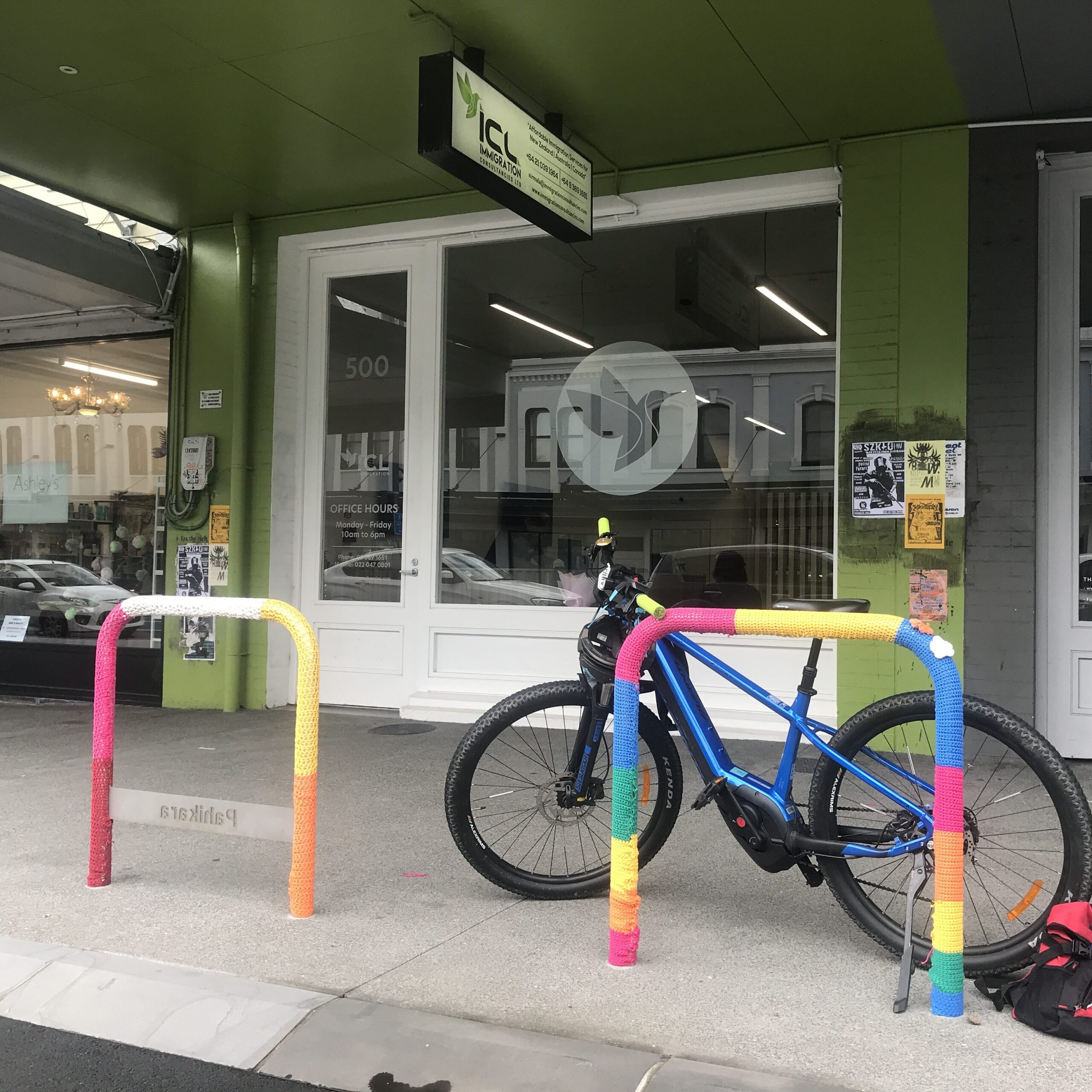
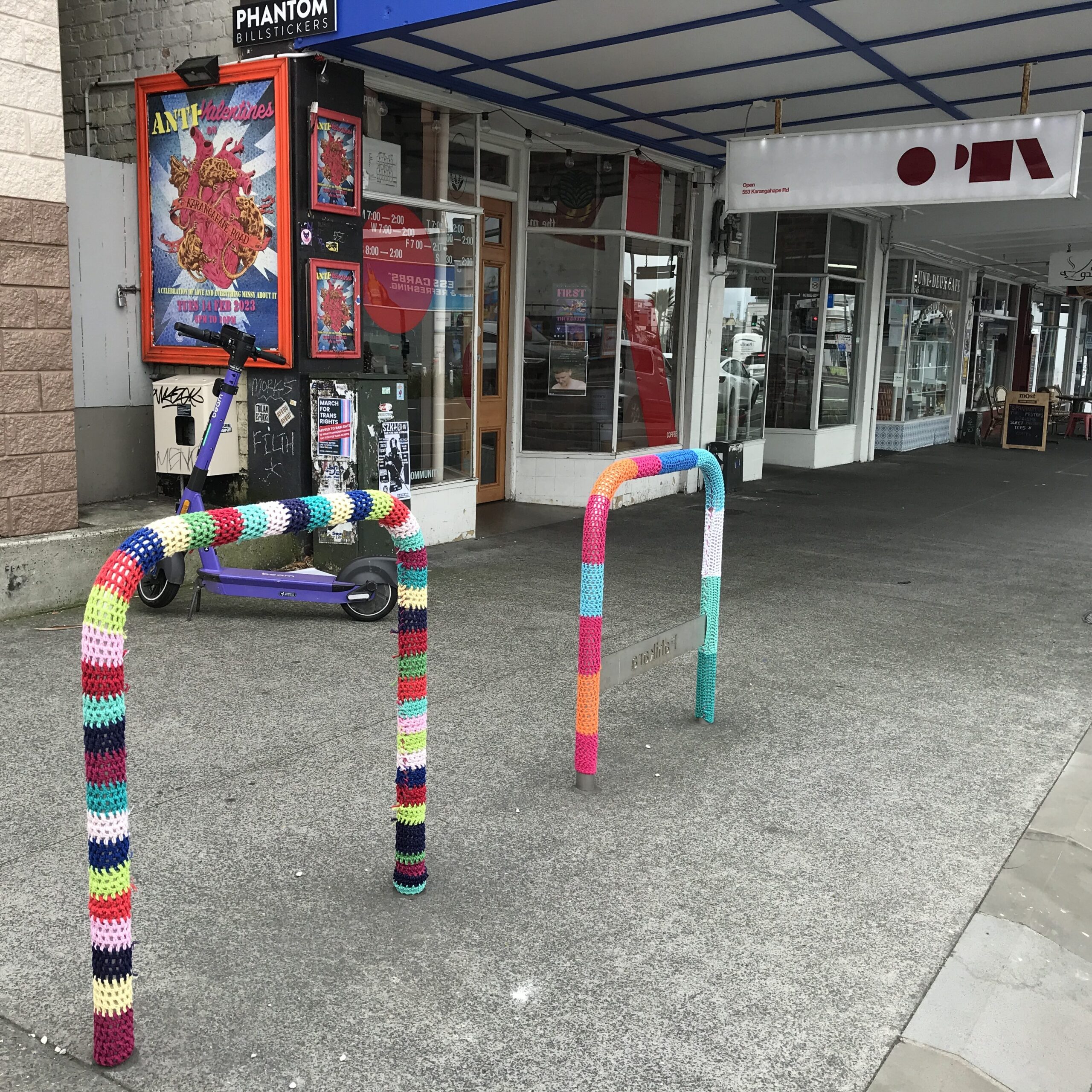
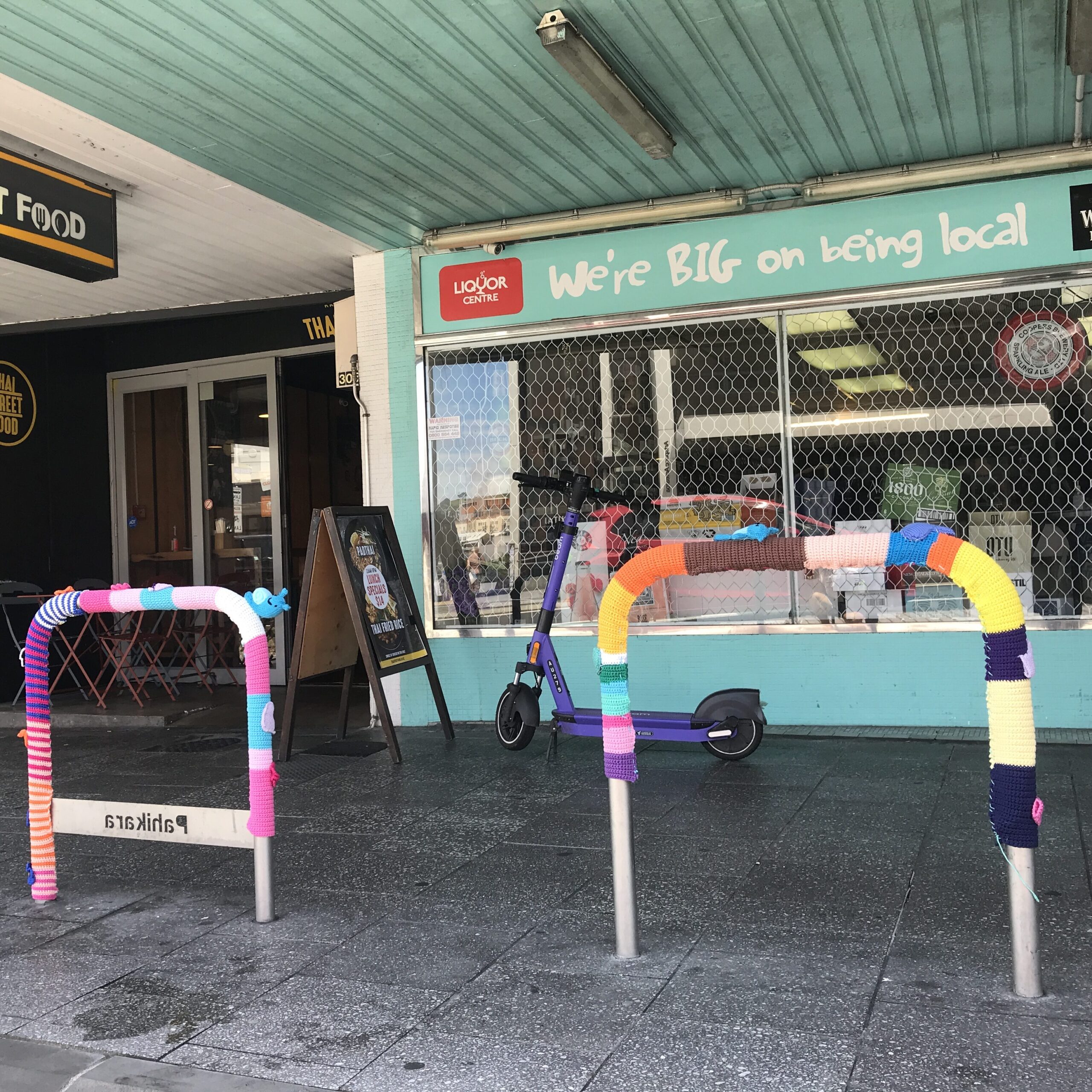
Checking on the pieces provides a great opportunity for picture taking, watching people’s happy faces as they stumble upon the yarnbombs, and feeling good about your handiwork!
Step 7
Removal
Depending on the type of yarn that you have used you may find that there is a natural time to remove your scarf by. If you use cotton, like us, then it will fade over time in the sun. After a month or two it will start to look raggy and need to be removed – or flipped over! The underside will still be bright and colourful so you could simply flip it over and reuse it.
To remove them, simply find the contrasting colour which you sewed the scarf on with and snip it! Be careful not to snip the pieces of yarn which the scarf is made from as it will then start to unravel!
Once the pieces are removed, you can wash them (cold and gentle setting on washing machine), dry them on the line, mend them if needed, and use them again for a later project!
Or, if they’re not up to scratch, you can throw them away and start fresh. If they’re biodegradable (like cotton is) they can go into the compost!
As Yarn for Pride is part of Auckland Pride month, we have a natural timeline to put the scarves up and then to remove them. We begin to put the scarves up from January the 20th, giving us volunteers more time to get them up for February. Because it’s a project which is open for anyone from the community to contribute to, some scarves won’t get put up until late February. We start to remove the scarves in mid-March, giving those late additions a bit of extra time to be enjoyed. Then we wash them, dry them, mend them, and keep them aside again for the next year’s Yarn for Pride!
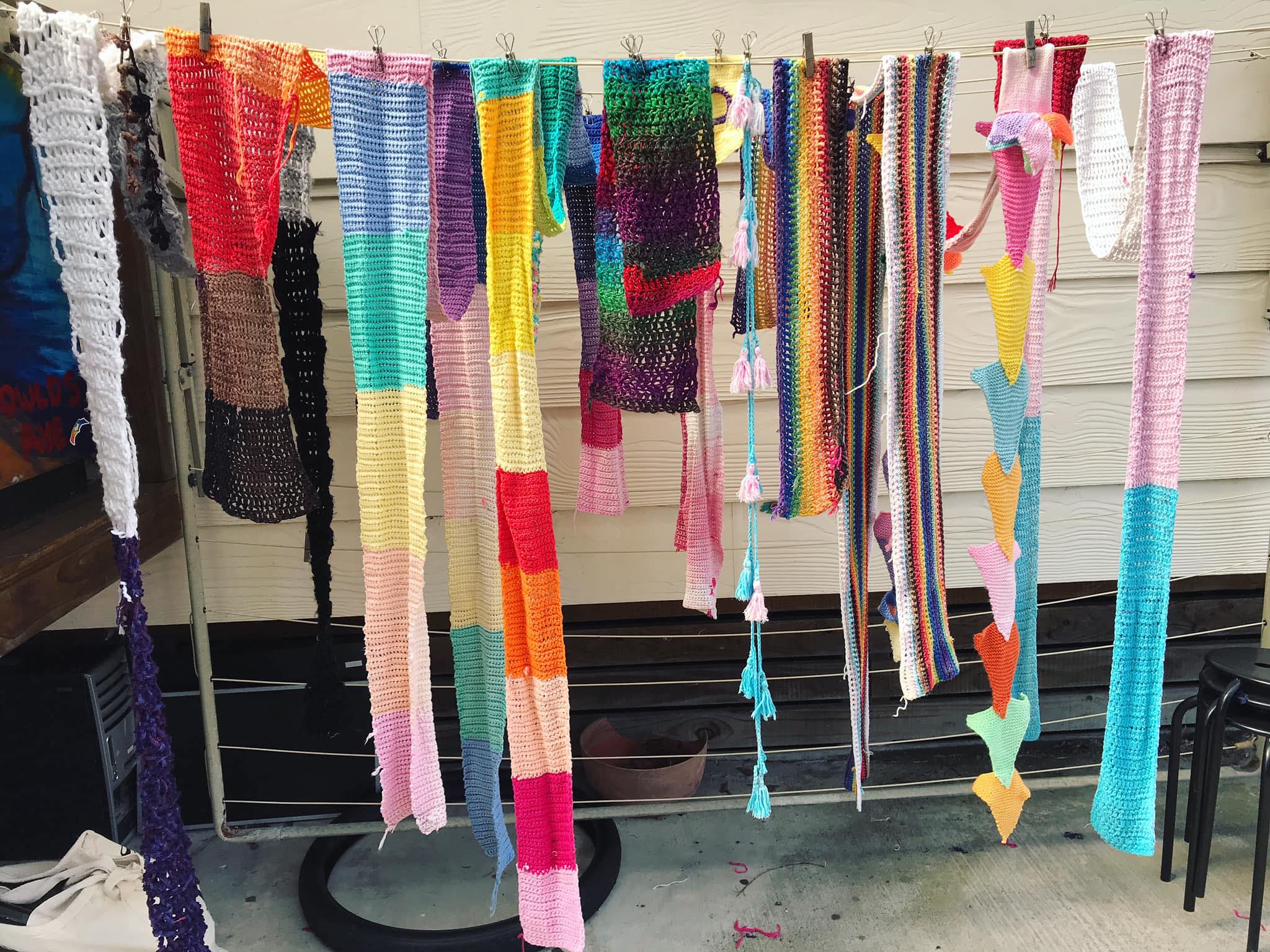
Getting a permit….
Technically to decorate the bike parking in Aotearoa NZ as an event you need to get an event permit from Council. However, if you’re not doing it as an event, and you’ve gotten permission from the shop owners that the bike parking is outside of, I’m not really sure if you legally need a permit or not. If you’re worried you could Email Auckland Council to ask.
To apply for a permit in Tāmaki Makaurau Auckland, click here. If you need any help navigating the process, hit us up! You can message Yarn for Pride on Facebook or Email fio@bikeauckland.org.nz – I’d be happy to help.
To Permit or Not To Permit?
Pro’s
- The yarnbombs are less likely to be removed by a Council person if you have a permit. I’m not sure if the Council would actually remove it if you didn’t get a permit though. Better safe than sorry?
- People are less upset about you putting it up. Through Yarn for Pride we discovered that, although most people are super happy to see the bike parking being decorated, there is the occasional person who is upset we are “vandalising” public property. They calm right down upon being told that we have a public permit from the Council and that it’s a legal activity.
- Having a permit enables you to include the decorated bike parking as part of a wider event eg. arts festival, heritage festival, Pride display.
- You’ll need a permit if you get funding for your project. Funders want everything to be above board and okay-ed by the Council.
Cons
- The permit costs money! For Yarn for Pride it’s usually $95. We make sure our funding covers this.
- The process of applying for the permit is largely irrelevant to this activity (eg. filling in a ‘crowd’ form to tell them that there won’t be a crowd generated from the event, assuring them that yarn won’t damage the bike parking, etc.)
- It’s more life admin. And we all already have too much of that!
If the local business association likes your project (K rd Business Association loves Yarn for Pride!) they may help you to get a permit, or may cover the cost of one – it’s worth asking!
P.S. If you’d like to get involved with Yarn for Pride but you haven’t made anything, no worries! We have lots of scarves and we need all the help we can get putting them up! Message Yarn for Pride on Facebook or email fio@bikeauckland.org.nz and Fio will rope you in!
P.P.S. If you’ve made a scarf but can’t put it up yourself please send it to the Karangahape rd business association and we’ll collect it. Their address is: Shop 8/59 Pitt Street, Newton, Auckland 1010

Make a trip to Karangahape road this Pride Month (February) to check out Yarn for Pride!


